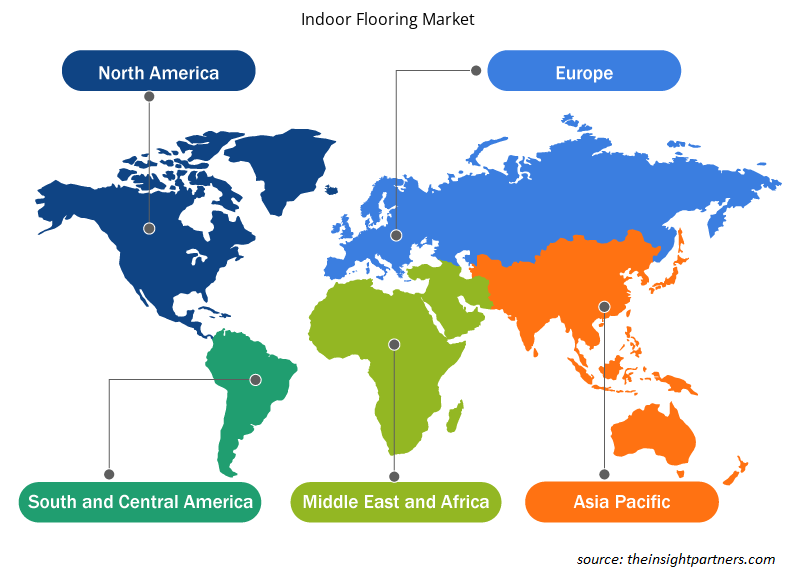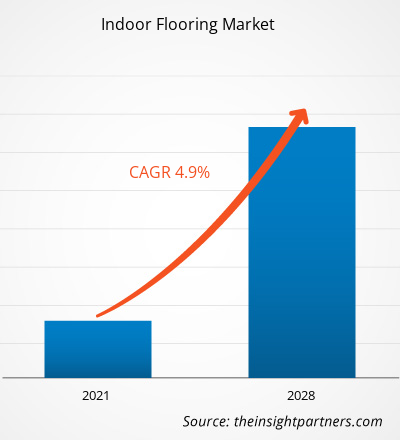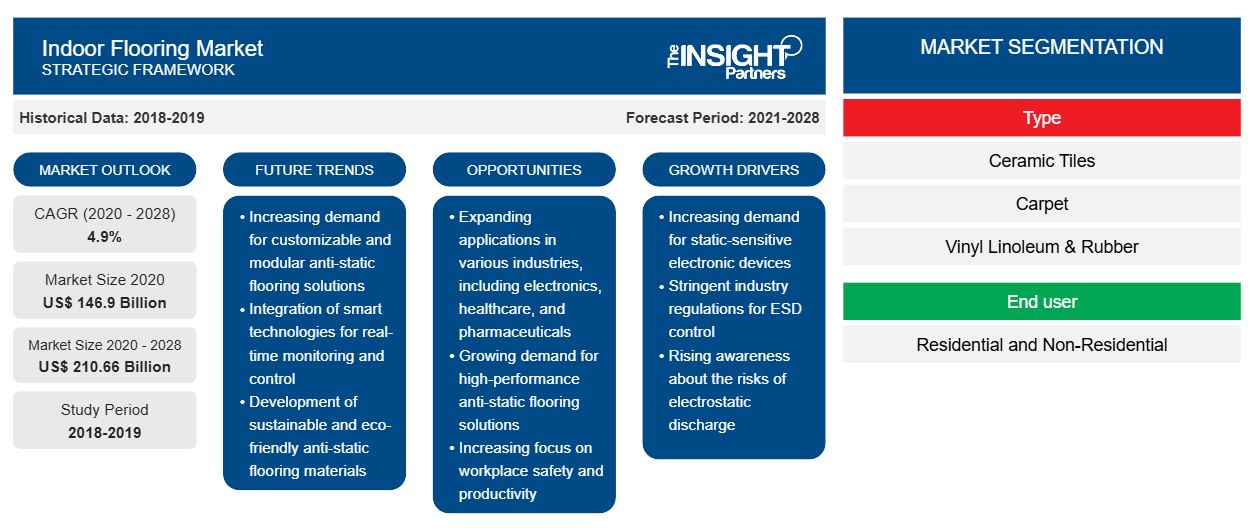[Informe de investigación] El mercado de pisos para interiores se valoró en US$ 146,90 mil millones en 2020 y se estima que crecerá a una CAGR del 4,9% durante el período de pronóstico de 2021 a 2028.
En entornos industriales como almacenes, hangares de aviones, plantas de ensamblaje, talleres de pintura, talleres de carrocería e instalaciones de distribución, los pisos de concreto están sujetos a desgaste por la exposición a productos químicos y aceites agresivos y corrosivos; también pueden dañarse por rayones y abrasiones causadas por máquinas y equipos pesados como aviones y carretillas elevadoras.
La rápida industrialización y el establecimiento de plantas de fabricación y procesamiento en las economías en desarrollo de la región APAC están impulsando la demanda de revestimientos para pisos, y las industrias farmacéutica, de alimentos y bebidas y de ensamblaje de automóviles son los principales generadores de demanda. Las corporaciones multinacionales de Europa y América están expandiendo sus operaciones en los países en desarrollo de la región APAC, como China e India. Con fabricantes de renombre que establecen sus instalaciones operativas en los países de esta región, la demanda de revestimientos para pisos de calidad industrial también está aumentando. El aumento de la demanda ha estado alentando a los fabricantes de pisos para interiores a introducir productos avanzados y genéricos, impulsando así el mercado de pisos para interiores.
Personalice este informe según sus necesidades
Obtendrá personalización en cualquier informe, sin cargo, incluidas partes de este informe o análisis a nivel de país, paquete de datos de Excel, así como también grandes ofertas y descuentos para empresas emergentes y universidades.
-
Obtenga las principales tendencias clave del mercado de este informe.Esta muestra GRATUITA incluirá análisis de datos, desde tendencias del mercado hasta estimaciones y pronósticos.
Impacto de la pandemia de COVID-19 en el mercado de pisos para interiores
El brote de COVID-19 ha afectado significativamente al desarrollo de la infraestructura y a la economía global. La respuesta internacional a la rápida interrupción de los sectores e industrias clave de la infraestructura está en curso. Según el último informe de situación de la Organización Mundial de la Salud, Estados Unidos, India, Brasil, Rusia, el Reino Unido, Francia, España e Italia se encuentran entre los países más afectados debido al brote de COVID-19. El brote comenzó en Wuhan (China) en diciembre de 2019 y, desde entonces, se ha extendido por todo el mundo. La crisis de COVID-19 ha afectado a las industrias de todo el mundo. La economía mundial se vio afectada negativamente en 2020, lo que probablemente continuará en 2021. La pandemia ha perturbado a las empresas y proveedores de suelos de interior de todo el mundo. Los actores del mercado experimentaron interrupciones en sus operaciones y es probable que se enfrenten a consecuencias hasta mediados de 2021. Los cierres de fábricas, las prohibiciones comerciales y los cierres fronterizos han afectado negativamente a la industria de los suelos de interior. En el lado de las aletas, el mercado se abrirá en 2021, por lo que se espera que gane tracción en un futuro próximo.
Perspectivas del mercado de suelos para interiores
Uso creciente de revestimientos para suelos en complejos deportivos
Los sistemas de revestimiento de suelos utilizados en estadios deportivos interiores y exteriores necesitan la combinación adecuada de propiedades como una excelente elasticidad puntual, resistencia al deslizamiento, elasticidad superficial y rebote. También deben ser extremadamente duraderos, a la vez que muestran excelentes características ópticas y compatibilidad con los materiales colorantes y aditivos de uso común. Los revestimientos de suelo de poliuretano de alto rendimiento imparten una excelente elasticidad y un buen agarre a las superficies, al tiempo que permiten a los jugadores ser ágiles y moverse hábilmente en la cancha, lo que lo convierte en un material preferido para revestir suelos en pabellones deportivos interiores; canchas de tenis, voleibol y baloncesto; y pabellones de lucha libre y gimnasia. El aumento del gasto de los gobiernos y las empresas de construcción privadas en la construcción de complejos y estadios deportivos ha llevado al desarrollo de numerosas instalaciones deportivas en áreas urbanas y suburbanas, lo que probablemente generará una gran demanda de materiales especializados de alto rendimiento para suelos de interior en los próximos años.
Perspectivas del mercado basadas en tipos
Según el tipo, el mercado de suelos de interior se clasifica en baldosas de cerámica, moqueta, vinilo, linóleo y caucho, madera y laminado, entre otros. El segmento de baldosas de cerámica dominó el mercado de suelos de interior. Las baldosas de cerámica se utilizan ampliamente para mejorar los suelos de casas, habitaciones de hospitales y baños. Están ampliamente disponibles en el mercado. La cerámica también se conoce como porcelana. Las baldosas de cerámica también se utilizan para suelos y paredes. Están disponibles en una amplia gama de variedades basadas en texturas, patrones y tamaños. En los mercados globales y locales, muchos actores ofrecen diferentes tipos de productos relacionados.
Los actores que operan en el mercado de pisos para interiores se centran en estrategias como fusiones, adquisiciones e iniciativas de mercado para mantener sus posiciones en el mercado. A continuación, se enumeran algunos avances de los actores clave:
- En 2020, según fuentes de desarrollo económico estatales y locales, Shaw Industries Group invirtió 20 millones de dólares para construir un nuevo espacio en Ringgold. La empresa planea ocupar el nuevo espacio en Ringgold el 1 de junio de 2021 aproximadamente.
- En 2018, Interface amplía su alcance en el sector de los suelos de alto rendimiento con la adquisición de una empresa de suelos de caucho
Perspectivas regionales del mercado de suelos para interiores
Los analistas de Insight Partners explicaron en detalle las tendencias y los factores regionales que influyen en el mercado de suelos para interiores durante el período de pronóstico. Esta sección también analiza los segmentos y la geografía del mercado de suelos para interiores en América del Norte, Europa, Asia Pacífico, Oriente Medio y África, y América del Sur y Central.

- Obtenga datos regionales específicos para el mercado de pisos para interiores
Alcance del informe de mercado de suelos para interiores
| Atributo del informe | Detalles |
|---|---|
| Tamaño del mercado en 2020 | US$ 146,9 mil millones |
| Tamaño del mercado en 2028 | US$ 210,66 mil millones |
| Tasa de crecimiento anual compuesta (CAGR) global (2020-2028) | 4,9% |
| Datos históricos | 2018-2019 |
| Período de pronóstico | 2021-2028 |
| Segmentos cubiertos |
Por tipo
|
| Regiones y países cubiertos |
América del norte
|
| Líderes del mercado y perfiles de empresas clave |
|
Densidad de actores del mercado de suelos para interiores: comprensión de su impacto en la dinámica empresarial
El mercado de suelos para interiores está creciendo rápidamente, impulsado por la creciente demanda de los usuarios finales debido a factores como la evolución de las preferencias de los consumidores, los avances tecnológicos y una mayor conciencia de los beneficios del producto. A medida que aumenta la demanda, las empresas amplían sus ofertas, innovan para satisfacer las necesidades de los consumidores y aprovechan las tendencias emergentes, lo que impulsa aún más el crecimiento del mercado.
La densidad de actores del mercado se refiere a la distribución de las empresas o firmas que operan dentro de un mercado o industria en particular. Indica cuántos competidores (actores del mercado) están presentes en un espacio de mercado determinado en relación con su tamaño o valor total de mercado.
Las principales empresas que operan en el mercado de suelos para interiores son:
- Forbo Internacional SA
- Esteras Inc.
- Tarkett
- Pisos Armstrong, Inc.
- Grupo Internacional Beaulieu
Descargo de responsabilidad : Las empresas enumeradas anteriormente no están clasificadas en ningún orden particular.

- Obtenga una descripción general de los principales actores clave del mercado de pisos para interiores
El mercado mundial de suelos de interior se ha segmentado de la siguiente manera:
Mercado mundial de suelos para interiores: por tipo
- Azulejos de cerámica
- Alfombra
- Linóleo vinílico y caucho
- Madera y laminado
- Otros
Mercado mundial de suelos para interiores (por usuario final)
- Residencial
- No residencial
Mercado mundial de suelos para interiores, por geografía
-
América del norte
- A NOSOTROS
- Canadá
- México
-
Europa
- Francia
- Alemania
- Italia
- Rusia
- Reino Unido
- Resto de Europa
-
Asia Pacífico (APAC)
- Porcelana
- India
- Japón
- Australia
- Corea del Sur
- Resto de APAC
-
Oriente Medio y África (MEA)
- Arabia Saudita
- Emiratos Árabes Unidos
- Sudáfrica
- Resto de MEA
-
América del Sur y Central (SCAM)
- Brasil
- Argentina
- Resto de estafa
Perfiles de empresas
- Forbo Internacional SA
- Esteras Inc.
- Tarkett
- Pisos Armstrong, Inc.
- Grupo Internacional Beaulieu
- Ecore Internacional
- Interfaz, Inc.
- Corporación Toli
- Industrias Mohawk, Inc.
- Grupo de Industrias Shaw, Inc.
- Análisis histórico (2 años), año base, pronóstico (7 años) con CAGR
- Análisis PEST y FODA
- Tamaño del mercado, valor/volumen: global, regional y nacional
- Industria y panorama competitivo
- Conjunto de datos de Excel
Informes recientes
Testimonios
Razón para comprar
- Toma de decisiones informada
- Comprensión de la dinámica del mercado
- Análisis competitivo
- Información sobre clientes
- Pronósticos del mercado
- Mitigación de riesgos
- Planificación estratégica
- Justificación de la inversión
- Identificación de mercados emergentes
- Mejora de las estrategias de marketing
- Impulso de la eficiencia operativa
- Alineación con las tendencias regulatorias























 Obtenga una muestra gratuita para - Mercado de suelos para interiores
Obtenga una muestra gratuita para - Mercado de suelos para interiores